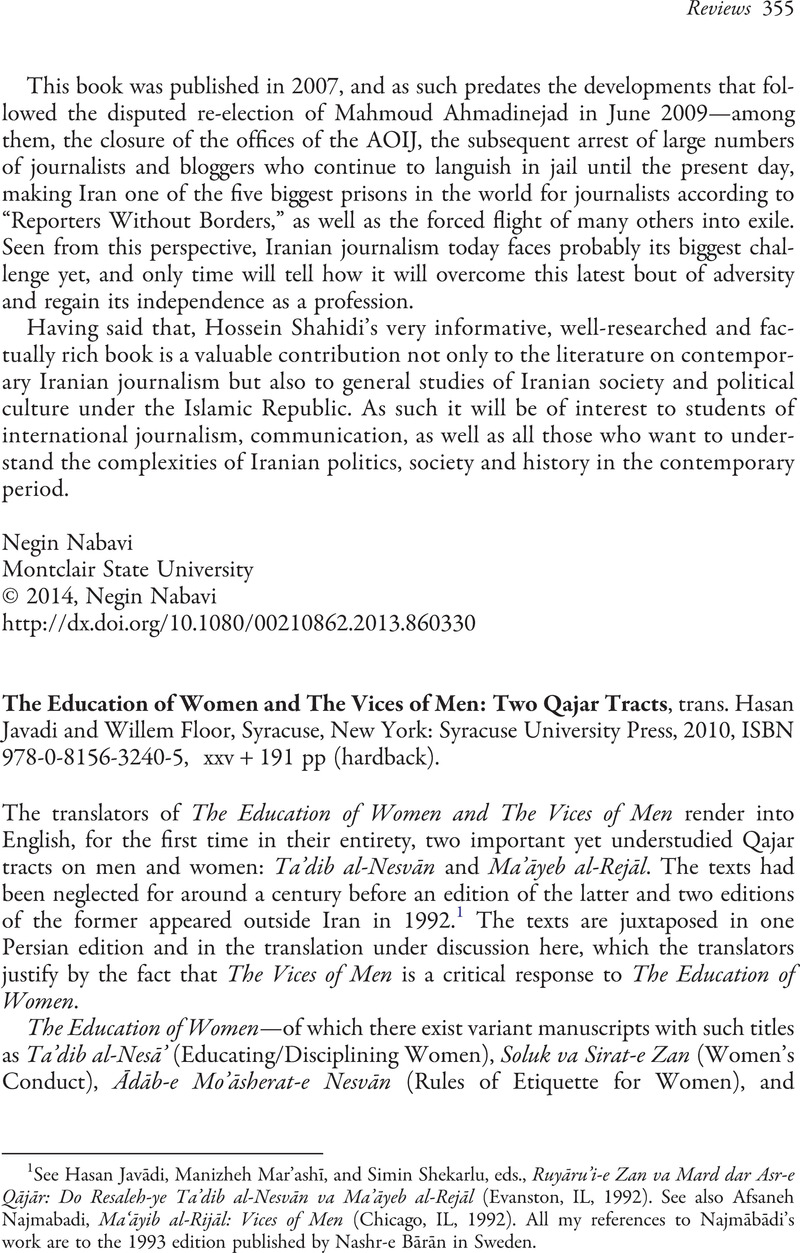No CrossRef data available.
Article contents
The Education of Women and The Vices of Men: Two Qajar Tracts, trans. Hasan Javadi and Willem Floor, Syracuse, New York: Syracuse University Press, 2010, ISBN 978-0-8156-3240-5, xxv + 191 pp (hardback).
Published online by Cambridge University Press: 01 January 2022
Abstract

- Type
- Reviews
- Information
- Copyright
- Copyright © 2013, Mostafa Abedinifard
References
1 See Javādi, Hasan, Mar'ashī, Manizheh, and Shekarlu, Simin, eds., Ruyāru'i-e Zan va Mard dar Asr-e Qājār: Do Resaleh-ye Ta'dib al-Nesvān va Ma'āyeb al-Rejāl (Evanston, IL, 1992)Google Scholar. See also Najmabadi, Afsaneh, Ma‘āyib al-Rijāl: Vices of Men (Chicago, IL, 1992)Google Scholar. All my references to Najmābādi's work are to the 1993 edition published by Nashr-e Bārān in Sweden.
2 Karāchi, Ruhangiz, “Nevisandeh-ye Asli-e Ta'dib al-Nesvān Kist?” [Who Is The Original Author of Ta'dib al-Nesvān?], Tārikh-e Adabiyāt 65, no. 3 (1389/2010): 199–208Google Scholar.
3 Karāchi, “Nevisandeh-ye Asli-e Ta'dib al-Nesvān Kist?,” 203–5.
4 For a concise account of some such theories, see Nida, Eugene, “Principles of Correspondence,” in The Translation Studies Reader, ed. Venuti, Lawrence (London, 2000), 131–4Google Scholar.
5 Damrosch, David, How to Read World Literature (Malden, MA, 2009), 66Google Scholar.
6 See, for instance, Kimmel, Michael S., “Consuming Manhood: The Feminization of American Culture and the Recreation of the Male Body, 1832–1920,” in History of Men: Essays on the History of American and British Masculinities (Albany, NY, 2005), 37–59Google Scholar.
7 See Najmabadi, Ma'āyeb al-Rejal, 10–11.
8 Javadi, Mar'ashi, and Shekarlu, Ruyāru'i-e Zan va Mard dar Asr-e Qājār, 22.
9 Najmabadi, Ma'āyeb al-Rejal, 12–17.
10 Ibid., 16–17, 37.
11 Javadi, Mar'ashi, and Shekarlu, Ruyāru'i-e Zan va Mard dar Asr-e Qājār, 63.
12 Ibid., 76.
13 Ibid., 142.
14 Ibid., 144.
15 Afary, Janet, “On the Origins of Feminism in Early 20th-Century Iran,” Journal of Women's History 1, no. 1 (1989): 65–87CrossRefGoogle Scholar.
16 For conjectures on the circulation of Ma'āyeb al-Rejāl, see Najmabadi, Afsaneh, “Bibi Khanum,” The Oxford Encyclopedia of Women in World History, ed. Smith, Bonnie G. (Oxford, 2008), 229Google Scholar.
17 For an insightful essay which puts Aqā'ed al-Nesā in its historical and political context, see Babayan, Kathryn, “The ‘Aqā’īd Al-Nisā': A Glimpse at Ṣafavid Women in Local Iṣfahānī Culture,” in Women in the Medieval Islamic World: Power, Patronage, and Piety, ed. Hambly, Gavin (New York, 1998), 349–81Google Scholar.
18 Billig, Michael, Laughter and Ridicule: Towards a Social Critique of Humour (London, 2005)Google Scholar.
19 See Najmabadi, Afsaneh, Women with Mustaches and Men without Beards: Gender and Sexual Anxieties of Iranian Modernity (Berkeley, CA, 2005)CrossRefGoogle Scholar.
20 See Afary, Sexual Politics in Modern Iran, 134–41.


